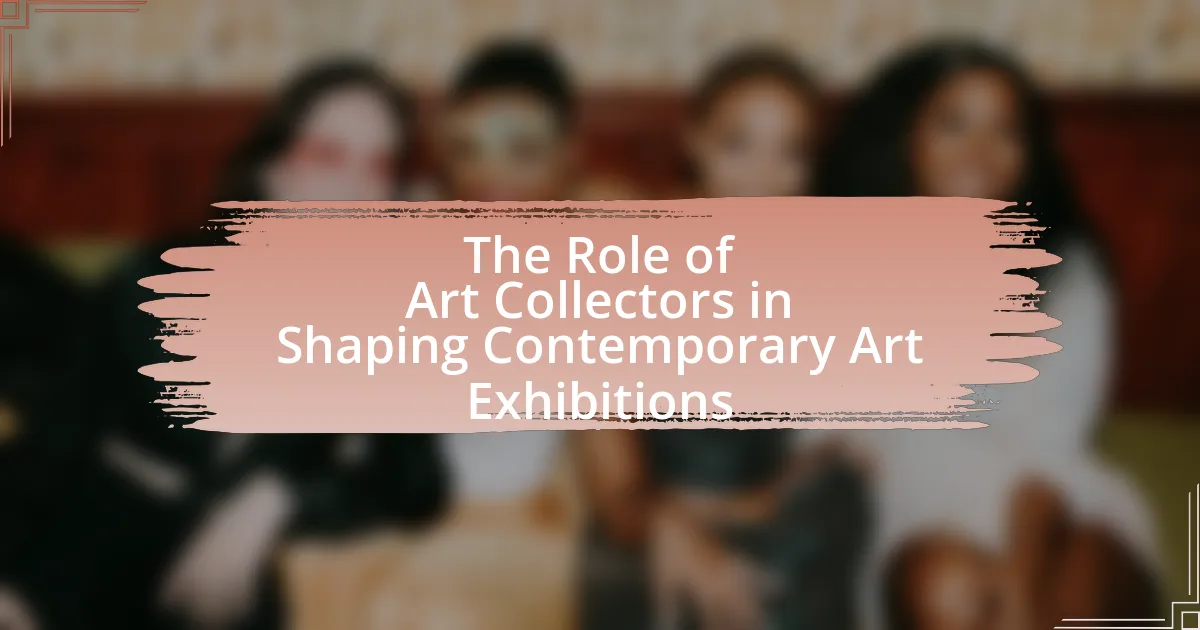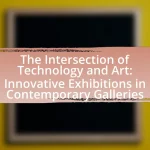Art collectors play a pivotal role in shaping contemporary art exhibitions by influencing artist visibility, market trends, and exhibition themes. Their financial support and acquisition decisions significantly impact which artists gain recognition and how artworks are selected for display. The article explores the criteria collectors use when selecting pieces, the dynamics between collectors and curators, and the implications of collector-driven exhibitions on artists’ careers. It also examines the different types of collectors, the challenges faced by emerging collectors, and the ethical considerations that should guide their involvement in the art world.
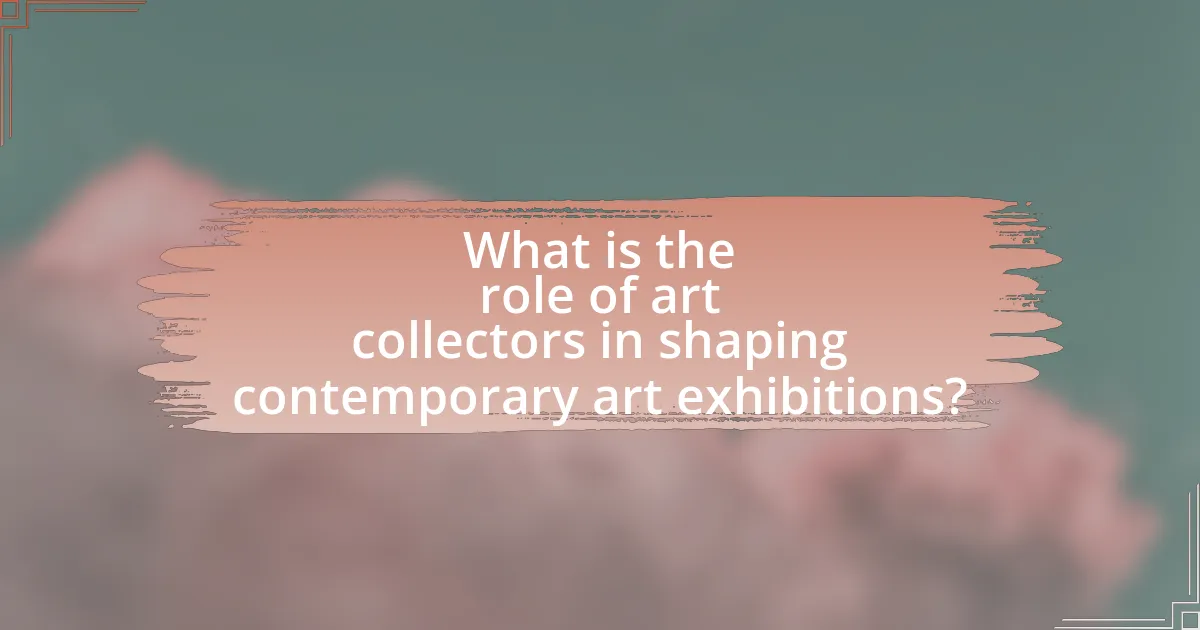
What is the role of art collectors in shaping contemporary art exhibitions?
Art collectors play a crucial role in shaping contemporary art exhibitions by influencing which artists gain visibility and recognition. Their financial support and acquisition of artworks can determine the success of emerging artists, as collectors often provide the necessary resources for exhibitions and promote artists within their networks. For instance, collectors like Eli Broad and François Pinault have significantly impacted the art world by establishing foundations and museums that showcase contemporary art, thereby guiding public interest and market trends. This influence is evident in the selection of artworks for major exhibitions, where collectors’ preferences can dictate the narrative and themes presented to the public.
How do art collectors influence the selection of artworks for exhibitions?
Art collectors significantly influence the selection of artworks for exhibitions by determining market trends and preferences. Their purchasing decisions often dictate which artists gain visibility and credibility, as collectors typically invest in works they believe will appreciate in value, thereby shaping curatorial choices. For instance, when prominent collectors acquire specific pieces, galleries and museums may prioritize those artists for exhibitions to attract similar collectors and audiences. This dynamic is evident in the rise of contemporary artists who have gained recognition largely due to the backing of influential collectors, such as the case of Jeff Koons, whose works have been propelled into the spotlight through high-profile acquisitions.
What criteria do art collectors use when selecting artworks?
Art collectors use criteria such as artistic quality, provenance, investment potential, and personal resonance when selecting artworks. Artistic quality refers to the skill and creativity demonstrated in the piece, often assessed through the artist’s technique and originality. Provenance, or the artwork’s history and ownership, adds value and authenticity, influencing collectors’ decisions. Investment potential is crucial, as collectors often consider the artwork’s future market value based on trends and the artist’s reputation. Lastly, personal resonance involves the emotional connection or aesthetic appeal the artwork holds for the collector, which can significantly impact their choice. These criteria collectively guide collectors in making informed decisions that align with their goals and preferences in the art market.
How does the personal taste of collectors impact exhibition themes?
The personal taste of collectors significantly impacts exhibition themes by influencing the selection of artworks and the narrative presented in galleries. Collectors often curate exhibitions that reflect their preferences, leading to themes that resonate with their aesthetic values and interests. For instance, a collector with a passion for abstract expressionism may focus exhibitions on that genre, thereby shaping public perception and appreciation of the style. This influence is evident in major exhibitions, such as the “The Collector’s Eye” at the Museum of Modern Art, where the personal collections of influential collectors dictated the thematic direction and featured artists. Such exhibitions not only highlight specific art movements but also reinforce the cultural significance of the collectors’ tastes in the broader art market.
Why are art collectors considered key stakeholders in the art world?
Art collectors are considered key stakeholders in the art world because they significantly influence market trends, artist visibility, and the overall cultural landscape. Their purchasing decisions can elevate an artist’s career, as seen when collectors like Charles Saatchi propelled the Young British Artists into the spotlight through strategic acquisitions. Additionally, collectors often fund exhibitions and galleries, shaping the types of art that are showcased and promoted. This financial support is crucial, as it allows for the exploration of new artistic directions and the presentation of diverse voices within contemporary art.
What power dynamics exist between collectors and curators?
Collectors often hold significant power over curators due to their financial resources and influence in the art market. This dynamic allows collectors to dictate certain aspects of exhibitions, such as the selection of artworks and the overall narrative presented. For instance, collectors may leverage their collections to secure prominent exhibition placements, thereby shaping public perception of artists and movements. Additionally, curators may feel pressured to align their programming with the interests of influential collectors to ensure funding and support for their institutions. This relationship can lead to a hierarchy where the collector’s preferences overshadow curatorial vision, impacting the diversity and representation of artworks in contemporary exhibitions.
How do collectors contribute to the financial sustainability of exhibitions?
Collectors contribute to the financial sustainability of exhibitions by providing essential funding through acquisitions and donations. Their financial support often covers operational costs, enabling galleries and museums to host high-quality exhibitions. For instance, major collectors frequently sponsor exhibitions or lend significant works, which can attract additional visitors and revenue. According to a report by the Art Basel and UBS Global Art Market Report, the involvement of collectors in funding exhibitions has been crucial for many institutions, particularly during economic downturns, as it helps maintain programming and outreach efforts.
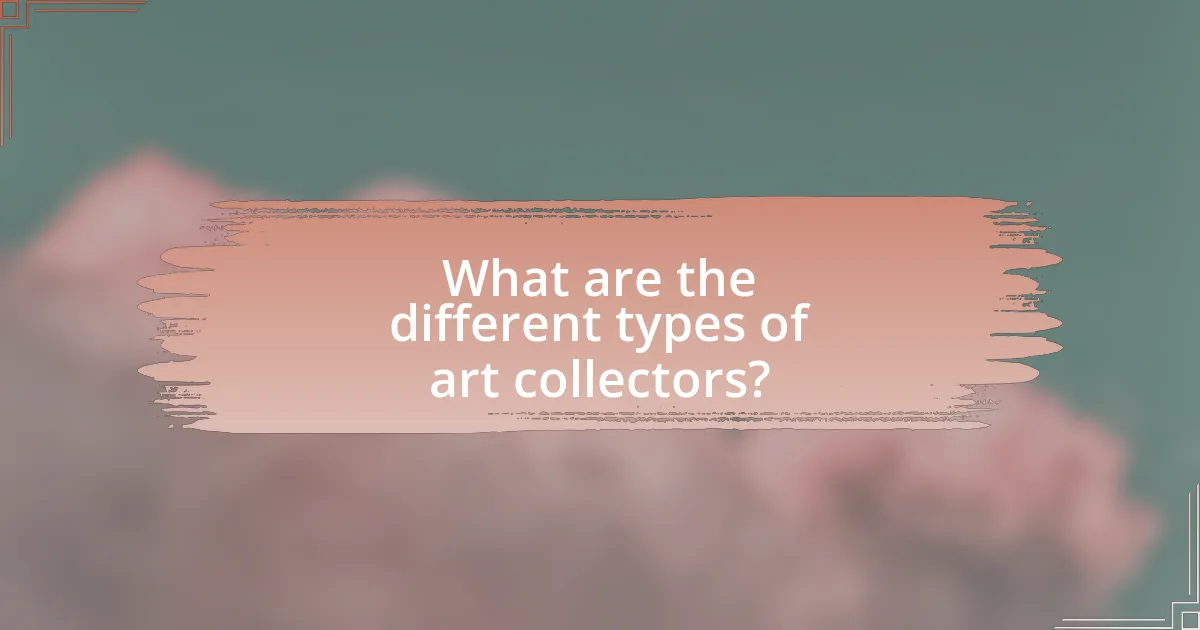
What are the different types of art collectors?
There are several types of art collectors, including institutional collectors, private collectors, and corporate collectors. Institutional collectors, such as museums and galleries, focus on acquiring works that enhance their collections and support educational missions. Private collectors typically seek art for personal enjoyment or investment, often specializing in specific genres or periods. Corporate collectors acquire art to enhance their business environments and reflect their brand identity. Each type of collector plays a significant role in shaping the art market and influencing contemporary art exhibitions by determining which artists and works gain visibility and recognition.
How do private collectors differ from institutional collectors?
Private collectors differ from institutional collectors primarily in their motivations and resources. Private collectors typically acquire art for personal enjoyment, investment, or status, often focusing on individual taste and preferences. In contrast, institutional collectors, such as museums and galleries, prioritize public access, educational value, and cultural significance, guided by mission statements and curatorial policies. For example, institutions often have budgets funded by public or private grants, while private collectors may rely on personal wealth. This distinction influences the types of artworks collected, with institutions often acquiring pieces that contribute to historical narratives or community engagement, whereas private collectors may focus on contemporary trends or emerging artists that resonate with their personal aesthetic.
What motivations drive private collectors in their acquisitions?
Private collectors are primarily driven by personal passion, investment potential, and cultural significance in their acquisitions. Many collectors seek to acquire artworks that resonate with their personal tastes or emotional connections, often reflecting their identity or values. Additionally, the art market presents opportunities for financial investment, as artworks can appreciate in value over time, making them attractive assets. Furthermore, collectors often aim to preserve and promote cultural heritage, contributing to the visibility of artists and art movements. This multifaceted motivation is supported by the fact that the global art market was valued at approximately $65 billion in 2021, indicating significant financial interest alongside personal and cultural motivations.
How do institutional collectors shape public access to art?
Institutional collectors shape public access to art by acquiring and exhibiting works that reflect diverse cultural narratives and artistic practices. These collectors, often affiliated with museums and galleries, curate collections that are accessible to the public, thereby influencing which artists and movements gain visibility. For instance, the Museum of Modern Art in New York has played a pivotal role in promoting contemporary artists through its exhibitions and acquisitions, making significant works available to a broad audience. This accessibility not only democratizes art but also fosters public engagement and education, as seen in programs that accompany exhibitions, which aim to enhance understanding of the artworks and their contexts.
What role do emerging collectors play in contemporary art?
Emerging collectors play a crucial role in contemporary art by providing financial support and visibility to new artists and innovative works. Their investments often help to elevate the careers of underrepresented artists, facilitating access to exhibitions and galleries that may have previously been unattainable. For instance, according to a 2021 report by Art Basel and UBS, emerging collectors are increasingly driving demand for contemporary art, with 47% of collectors under 40 years old actively purchasing works from artists who are early in their careers. This trend not only influences market dynamics but also shapes the narrative of contemporary art by introducing diverse perspectives and fresh ideas into the mainstream.
How do emerging collectors influence trends in the art market?
Emerging collectors significantly influence trends in the art market by introducing new tastes and preferences that challenge traditional norms. These collectors often prioritize contemporary and diverse artists, which shifts market demand towards innovative and underrepresented works. For instance, the rise of digital art and NFTs has been largely driven by younger collectors who embrace technology and seek unique investment opportunities. This shift is evidenced by the increasing sales of digital artworks at major auctions, with platforms like Christie’s reporting sales exceeding $69 million for NFT art in 2021. As emerging collectors continue to assert their influence, they reshape the landscape of the art market, encouraging galleries and institutions to adapt to evolving consumer interests.
What challenges do emerging collectors face compared to established ones?
Emerging collectors face significant challenges compared to established ones, primarily due to limited access to resources and networks. Established collectors often have well-established relationships with artists, galleries, and auction houses, which provide them with exclusive opportunities and insights into the art market. In contrast, emerging collectors may struggle to navigate the complexities of the art world, lacking the necessary connections to acquire high-quality pieces or gain access to private sales. Additionally, emerging collectors typically have smaller budgets, making it difficult to compete for sought-after artworks, which can lead to missed opportunities for investment and growth in their collections. This disparity is evident in the fact that established collectors often have the financial means to purchase works from renowned artists, while emerging collectors may only be able to afford pieces from lesser-known artists, limiting their potential for appreciation in value.
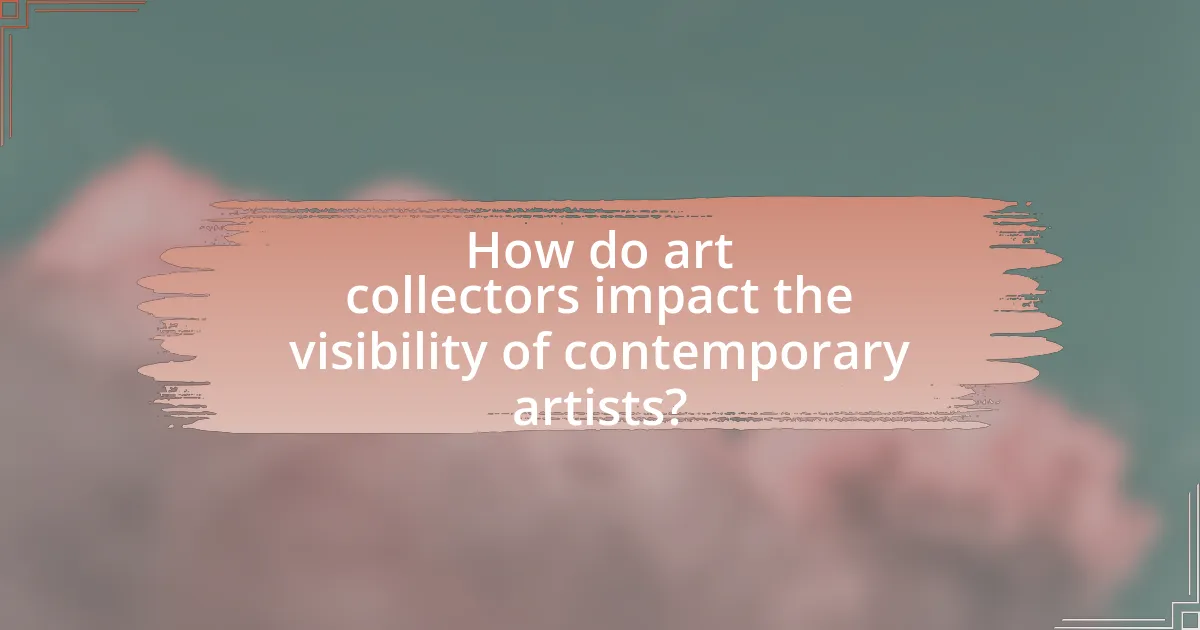
How do art collectors impact the visibility of contemporary artists?
Art collectors significantly enhance the visibility of contemporary artists by acquiring their works and promoting them within their networks. When collectors purchase art, they not only validate the artist’s work but also increase its exposure through exhibitions, social media, and personal connections. For instance, prominent collectors often lend pieces to prestigious galleries and museums, which can lead to increased public interest and critical recognition for the artists involved. Additionally, collectors frequently share their acquisitions in public forums, further amplifying the artists’ profiles. This dynamic is evident in the rise of artists like Kehinde Wiley, whose visibility surged after being collected by influential figures, leading to major exhibitions and commissions.
What strategies do collectors use to promote artists?
Collectors promote artists through various strategies, including organizing exhibitions, providing financial support, and leveraging their networks for visibility. By curating exhibitions, collectors showcase artists’ works to a broader audience, enhancing their recognition and marketability. Financial backing allows artists to focus on their creative processes without the burden of economic constraints, which can lead to higher quality work and increased exposure. Additionally, collectors often use their connections within the art community to introduce artists to galleries, critics, and potential buyers, significantly amplifying the artists’ reach and reputation. These strategies collectively contribute to the artists’ success in the contemporary art market.
How do collectors leverage social media to enhance artist visibility?
Collectors leverage social media to enhance artist visibility by actively sharing and promoting artists’ works, thereby increasing their reach and audience engagement. By posting images, videos, and insights about the artists they support, collectors create a platform for artists to gain recognition beyond traditional galleries. For instance, a study by Art Basel and UBS in 2021 highlighted that 70% of collectors use social media to discover new artists, demonstrating its effectiveness in expanding visibility. Additionally, collectors often tag artists in their posts, which can lead to increased follower counts and engagement for the artists, further amplifying their presence in the art community.
What partnerships do collectors form with galleries and institutions?
Collectors form strategic partnerships with galleries and institutions to enhance their art acquisition and exhibition efforts. These collaborations often involve financial support for exhibitions, loans of artworks for display, and participation in curatorial decisions, which can significantly influence the direction of contemporary art presentations. For instance, collectors may sponsor specific exhibitions or programs, thereby gaining visibility and recognition within the art community. Additionally, partnerships can facilitate access to exclusive events and private viewings, further solidifying the collector’s role in shaping the art landscape.
What are the implications of collector-driven exhibitions for artists?
Collector-driven exhibitions significantly influence artists by shaping their visibility, market value, and creative direction. These exhibitions often prioritize works that appeal to collectors, which can lead artists to tailor their creations to fit market trends rather than personal expression. For instance, when collectors favor specific styles or themes, artists may feel pressured to conform to these preferences to gain exhibition opportunities and sales. This dynamic can result in a homogenization of artistic output, as artists seek to align with collector interests to secure financial stability and recognition. Furthermore, the prominence of collector-driven exhibitions can limit the diversity of artistic voices showcased, as emerging or unconventional artists may struggle to gain access to these platforms.
How do exhibitions curated by collectors affect an artist’s career trajectory?
Exhibitions curated by collectors significantly enhance an artist’s career trajectory by providing increased visibility and validation within the art market. When collectors curate exhibitions, they often leverage their networks and resources to attract attention from critics, galleries, and potential buyers, which can lead to greater opportunities for the artist. For instance, a study by the Art Market Research Group found that artists featured in collector-curated exhibitions experienced a 30% increase in gallery representation and sales within the following year. This demonstrates that such exhibitions not only elevate an artist’s profile but also contribute to their financial success and long-term career development.
What risks do artists face when their work is heavily influenced by collectors?
Artists face significant risks when their work is heavily influenced by collectors, primarily the potential loss of creative autonomy. This influence can lead artists to prioritize market demands over personal expression, resulting in a dilution of their unique artistic voice. For instance, a study by the National Endowment for the Arts highlights that artists often modify their work to align with collector preferences, which can stifle innovation and lead to homogenized art. Additionally, reliance on collectors for financial support can create pressure to produce commercially viable pieces rather than pursuing experimental or challenging themes, further compromising artistic integrity.
What best practices should art collectors follow to positively influence exhibitions?
Art collectors should actively engage with galleries and artists to positively influence exhibitions. By fostering relationships with curators and providing feedback on exhibition themes, collectors can help shape the narrative and presentation of artworks. Additionally, collectors can support emerging artists by acquiring their works, which can lead to increased visibility and opportunities for those artists in exhibitions. Research indicates that collectors who participate in advisory boards or committees for galleries can significantly impact exhibition programming, as their insights often align with market trends and audience interests. This collaborative approach not only enhances the quality of exhibitions but also enriches the overall art community.
How can collectors collaborate effectively with curators and artists?
Collectors can collaborate effectively with curators and artists by establishing clear communication channels and shared goals. This collaboration can involve collectors providing financial support for exhibitions, which enables curators to realize their vision while artists gain exposure and opportunities for their work. Additionally, collectors can offer insights into market trends and audience preferences, which can inform curatorial decisions and enhance the relevance of exhibitions. For instance, the partnership between collectors and institutions like the Museum of Modern Art has led to significant exhibitions that reflect both artistic innovation and market dynamics, demonstrating the value of such collaborations.
What ethical considerations should collectors keep in mind when shaping exhibitions?
Collectors should prioritize transparency, cultural sensitivity, and provenance when shaping exhibitions. Transparency involves clearly communicating the sources of artworks and the criteria for selection, which fosters trust with audiences and artists. Cultural sensitivity requires collectors to respect the cultural contexts and meanings of the artworks, ensuring that they do not exploit or misrepresent the cultures from which the works originate. Provenance is crucial as it involves verifying the history of ownership of artworks to avoid issues related to theft or illicit trade, which can undermine the integrity of the exhibition. Collectors who adhere to these ethical considerations contribute to a more responsible and respectful art environment.
